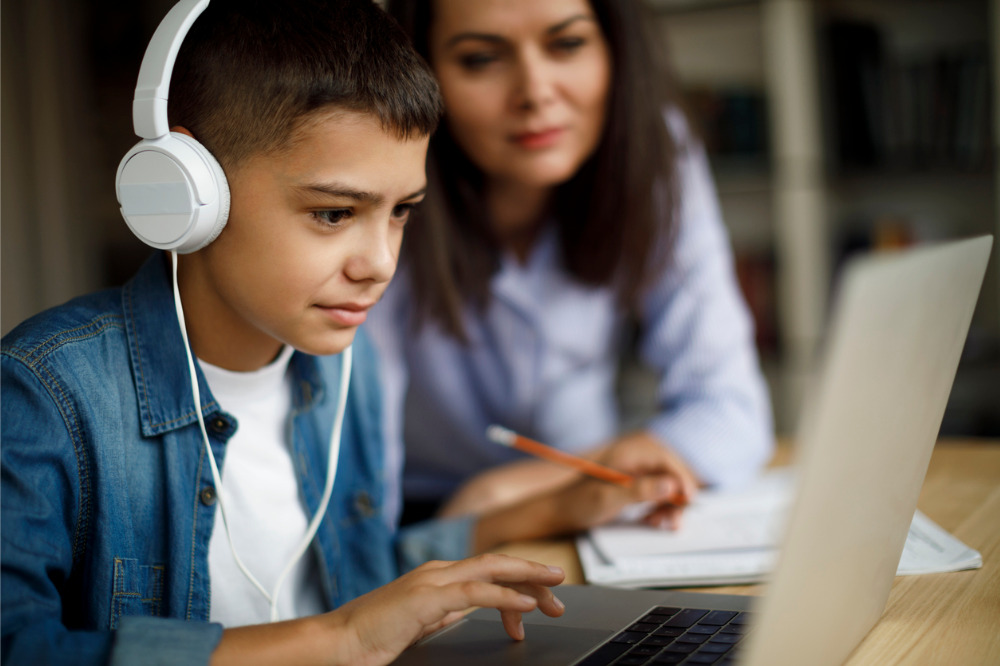
As Australia's vaccination rates continue to increase, lockdown home schooling is coming to an end for many families. However, the changes to education that have resulted from home schooling provide an opportunity to reflect upon what has happened and what we might decide to retain into the future.
A research team from Macquarie University including Professor Matt Bower, Dr Jennifer Lai, Associate Professor Penny Van Bergen, Lucie Hobson, Rebecca Stephens is surveying parents to learn about their experiences of home schooling, as a way to inform how we might reconceptualise learning and teaching going forward. Survey respondents were asked to pick one child that they were schooling from home and responding to questions about their experiences. So far they have responses from over 200 parents and carers from across 138 schools across Australia, and the results are interesting.
On average, respondents were spending 10.7 hours home schooling their child each week, and one or more other adults was spending 3.4 hours on average. That 14.1 hours of time that was added to parents and carers workload is a huge drain from national productivity, and that was only for the children that they were home schooling. Most typically, parents were schooling two children from home, and sometimes as many as four.
With such an increase to parent and carer workloads, it's not surprising that 84% agreed with the statement that schooling at home was stressful for them. In addition, 79% of respondents indicated that schooling at home was difficult for their child. Unsurprising, the younger the child, the more stressful it was for parents and carers, with primary school parents significantly more stressed than secondary school parents. The 35% of parents whose children only had shared access to technology were significantly more stressed by home schooling than the 64% of parents who children had uninterrupted access.
The cause of stress for parents and carers was most frequently identified the balancing act between work and home schooling (34%), with respondents who were balancing schooling at home and work on average working at their jobs 30 hours per week. They also found the social isolation and not being able to do any outdoor activities during lockdown to be stressful (27%). There were some who also raised their child’s lack of engagement and motivation to undertake online learning (19%), as well as technical and access issues (7%), as impediments.
The respondents indicated that on average their child spent approximately 4.3 hours schooling at home. On average children spent approximately 43 minutes each day undertaking web-conferencing with their teacher (e.g. via Zoom), though there was a big range, with 12% of children not having any live online interaction. On average children spent 39 minutes completing paper based activities, 34 minutes completing offline activities, 32 minutes completing digital worksheets, and 14 minutes each day watching videos (either publicly available or teacher created). Also, respondents indicated that students spent on average 26 minutes completing online learning quizzes and games, and 24 minutes reading online resources. Only 21 minutes each day appeared to be allocated to digital creativity tasks (such as creating essays, videos, posters etc).
On the whole, 38% of parents felt that to some extent their child was not able to learn independently using technology, but this was strongly correlated with the age of the child (with younger students considered less able to learn independently). For instance, 73% parents of children aged 5 felt that their child could not learn independently using technology, whereas when children had reached age 11 that had dropped to 13%.
Approximately 63% of parents felt that their child learnt less when schooling at home than they did when at school, 24% felt that child learnt the same. The perception of learning less was more pronounced for younger students.
There were other silver linings. Respondents appreciated the flexible curriculum and timetabling provided while learning from home (32%), where students could learn at their own pace. Many also indicated that there was increased time for family bonding (12%), and time saved travelling (5%). Strategies that parents and carers found worked well included injecting regular exercise breaks (7%) and build routines for their kids (7%).
The main things that parents wished they could change about schooling from home was to have more face to face (e.g. Zoom) interaction with teachers each day (28%), better differentiation for individual ability levels (20%), more teacher and school support (19%), and more offline learning opportunities to reduce the overall amount of screen time (17%).
Overall, schooling at home has been a huge undertaking for parents and teachers. The efforts of all involved have been highly commendable. Going forward, we can see that we should aspire to providing learning opportunities that are flexible and differentiated, as well as focus upon helping students develop the capabilities they need to effectively learn independently online.
If you would like participate in the Schooling At Home survey and go in the draw for a chance to win a HP laptop or an Amazon voucher then visit: https://bit.ly/sahsurvey


